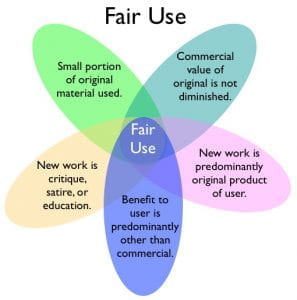It is important to know the guidelines of copyright and fair use as it not only makes sure that you don’t get any legal issues about the content you produce, but it also shows respect for other artists.
Definition of copyright according to the Merriam-Webster dictionary:
“: the exclusive legal right to reproduce, publish, sell, or distribute the matter and form of something (such as a literary, musical, or artistic work) His family still holds the copyright to his songs.”
https://www.merriam-webster.com/dictionary/copyright
However…
It is still possible to use material that is copyrighted in your content, you just have to make sure it follows the fair use guideline!!
The main guidelines when it comes to fair use:
https://www.resourcesforlife.com/docs/item6247
Below are a few video which will go over copyright and fair use in more detail:
In Australia, fair use rules don’t apply as such, but we have similar guidlines summed up under “fair dealing”.
Fair dealing: What can you do in Australia?
The key difference between “fair use” and “fair dealing” is that Australia’s “fair dealing” laws set out defined categories of acceptable uses. As we will see, “fair use” in the US is much more flexible.
Australian copyright law sets out five situations where use of copyrighted material without permission may be allowed:
- research or study
- criticism or review
- parody or satire
- reporting the news
- provision of legal advice.
When is a use ‘fair’?
Fair dealing only applies when the use is “fair”.
When assessing fairness in Australia, there are a number of relevant considerations, including:
- how important copying is to your work (“nature and purpose of the use”)
- the type of work being copied (less original works may not be protected as strongly as more creative works)
- whether it is easily possible to get a licence within a reasonable time at an ordinary commercial price
- the effect of your copying on the potential market for the original
- the amount taken from the original work
- whether attribution has been given to the original author.
Generally, a use will be fair if you are copying for a valid reason, you don’t copy more than you need, you give attribution where possible, and your work is not directly competing in the market against the original.
Things to remember:
- Is copying necessary? Copying has to be necessary for one of the purposes above. This means that it might be fair to copy part of a song to review it, but it won’t be fair if you’re just using the song as background music.
- Copy no more than you need. Sometimes you need to copy the entirety of an existing work – if you’re critiquing a photograph, for example. Usually, though, you should only copy the parts that are necessary. You can’t get away with showing a whole TV episode in order to critique one scene.
- It’s usually not fair if you’re competing with the original. This is often the most important factor. When you copy existing material for your own study, to report on the news, or to create a parody, you usually won’t be undercutting the market for the original. But if you’re just repackaging the original material in a way that might substitute for it – a consumer might be satisfied with your work instead of the original – then your use probably won’t be fair.
https://www.lifehacker.com.au/2017/07/fair-use-vs-fair-dealing-how-australian-copyright-law-differs/
